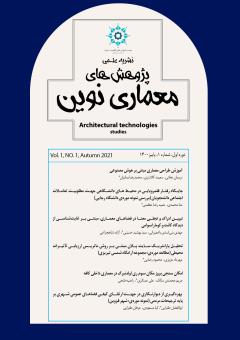تحلیل پارامتریک سایت پلان مبتنی بر روش ماتریس ارزیابی تأثیرات محیطی (مطالعه موردی: مجموعه آرامگاه شمس تبریزی)
محورهای موضوعی :
مهرداد عزیزی
1
![]() ,
محمود رضایی
2
,
محمود رضایی
2
![]()
1 - دانشجوی دکتری، گروه معماری، واحد تهران مرکزی، دانشگاه آزاد اسلامی، تهران، ایران.
2 - گروه معماري، واحد تهران مرکزی، دانشگاه آزاد اسلامی، تهران، ايران
کلید واژه: ارزیابی, ارزیابی تأثیرات محیطی, شبیهسازی, سایت پلان, تحلیل سایت.,
چکیده مقاله :
تجزیه و تحلیل سایت در فرآیند طراحی معماری باتوجه به فاکتورهای بسیار زیادی مورد بررسی قرار می گیرد که به منظور دست یابی به آن ها نیازمند یک سیستم ارزیابی کامل و فهم دقیقی از آن سیستم هستیم. هدف اصلی این پژوهش ارزیابی و شبیه سازی پارامتریک مؤلفه های تأثیرگذار در فرآیند تحلیل سایت پلان در شهر خوی و سایت مجموعه شمس تبریزی با بهره گیری از روش ماتریس ارزیابی تأثیرات محیطی است. پژوهش از نوع کمی است و با کمک فنون مدلسازی و شبیه سازی صورت گرفته است. برای ارزیابی دقیق تأثیر پارامترها، از نرم افزارهای معتبر معماری نظیر راینو و گرسهاپر بهره برده شده است. برای تحلیل و ارزیابی سایت عواملی نظیر بستر سایت، توپوگرافی، دسترسی، دید و منظر، آلودگی صوتی و نور آفتاب در نظر گرفته شدند. نتایج بررسی ها نشان دادند که در بین عوامل، عوامل توپوگرافی و ساختمان های اطراف بیشترین تأثیر را در محاسبات در یک سایت دارند. و بر اساس محاسبات الگوریتم ماتریس ارزیابی تأثیرات محیطی مشخص گردید، سلول هایی که نمرات 5 به بالا را دریافت کردند محدوده های مناسب و مطلوبی برای طراحی و ساخت می باشند. مؤلفه های تحلیلی سایت با الگوریتم سازی و روش پارامتریک می واند به شکل مستقیم و مؤثرتری در فرآیند طراحی قرار گیرد. به طوری که مرحله تحلیل در مرحله طراحی بر خلاف روش های سنتی آمیخته و یکی باشد. نتیجه این پژوهش دو دستاورد هم زمان است. ابتدا ارزیابی طرح های موجود و دیگری تهیه مولدی برای طرح های جدید یعنی علاوه بر اينكه مؤلفه هاي تحليل سايت مولدي براي طرح نهايي است، ابزاري جهت سنجش طرح هاي نهايي (اجرا شده يا نشده) محسوب مي شود.
In the architectural design process, the site is analyzed by different factors. These analyses require a complete assessment system and full knowledge. This research mainly looked to assess a parametric simulation of components affecting the site plan analysis in Khoi and the Shams Tabrizi Shrine using an environmental impacts assessment matrix. This quantitative research uses modeling and simulation techniques. To accurately assess the effects of the parameters, credible architectural software, Rhino and Grasshopper, were used. In order to analyze the site, such factors as the site bed, topography, accessibility, vision, perspective, noise pollution, and sunlight were considered. Results indicate that two factors, topography and surrounding buildings, contributed most to site calculations. According to algorithm calculations of environmental impacts assessment matrix, findings show that the cells with scores of higher than 5 were suitable areas for design and construction. Analytical components of the site can be used directly and more effectively in the design process using design algorithms and parametric methods, provided that the analysis step is an integrated method, unlike traditional methods. This research offers two takeaways. First, it provides an assessment of available plans. Second, a productive context for new plans; i.e., in addition to being a productive context for the final design, the site analysis components also serve as a vehicle to assess the final plans (both administered or unadministered ones).
1. جعفری، ت. و مقیمی، ا. (1399). تعیین مناطق ممنوع ژئومورفولوژیکی در شهر بجنورد بهمنظور مکانگزینی جهتهای مناسب توسعۀ شهری از دیدگاه مخاطرهشناسی. مدیریت مخاطرات طبیعی، 7(4)، 425-401.
2. عزیزی. م.، رضایی. م. و قبادیان، و. (1400). ارزیابی دید و منظر مطلوب با هدف کاهش مخاطرات زیست محیطی (مطالعۀ موردی: مجموعۀ شمس تبریزی). مدیریت مخاطرات طبیعی، 8(3)، 265 - 247
3. کرمشاهی، س. و صیدایی، ا. (1400). توزیع فضایی پایداری اقتصادی اجتماعی براساس عوامل محیطی (مطالعۀ موردی: مناطق روستایی استان ایلام). مدیریت مخاطرات طبیعی، 8(2)، 175- 157.
4. ماهان، ا. و منصوری، ا. (1396). تدوین مدل ارزیابی منظر (با مروری بر روشها و رویکردهای جاری ارزیابی منظر). باغ نظر، 14(56)، 42-33.
5. وایت، ا.ت. (1385). مفاهیم پایه در معماری. ترجمه احمدی نژاد، م. چاپ ششم، اصفهان، نشر خاک
6. Abaza, H. Bisset, R. Sadler, B. (2004). Environmental Impact Assessment and Strategic Environmental Assessment: Towards an Integrated Approach, UNEP, First Edition
7. Abedi, S. Iravani, H. (2015). Analysis of the Contextual Architecture and its Effect on the Structure of the Residential places in Dardasht Neighborhood of Isfahan, European Online Journal of Natural and Social Sciences, 4(3), 158.
8. Anhava, J, O Kolehmainen, (1994). Environmental impact assessment - valuable experiences of EIA procedure and public perception of major industrial projects. Wat Sci Tech, 29(5-6), 131 – 136
9. [9] Anderson, k. (2008). Environmental impact assessment, Sweden
10. Beer, A. Higgins, C. (2000). Environmental Planning for Site Development, A manual for sustainable local planning and design, Second Edition, Taylor & Francis Group
11. Canter, L. (1999). Environmental Impact Assessment. Florida: CRC Press LLC.
12. Haye, R. L. The Architect’s Handbook of Professional Practice, (2014), The American Institute of Architects. John Wiley & Sons, Canada
13. Kumari,.P. (2013). A Site Analysis Framework, Scribd digital library, San Francisco, USA, Scribd.com
14. Lagro, Jr. James, A. (2013). Site Analysis Informing Context-Sensitive and Sustainable Site Planning and Design, Third Edition, John Wiley & Sons, Canada
15. Mehrabi, M. (2016). Consideration of Climate Impact on Contextual Architecture in Arid Region, The Turkish Online Journal of Design, Art and Communication
16. Mishra, P. Patnayaka, R. (2015). Simulation in Architectural Research, National Institute of Technology Rourkela
17. Morgan, R K (1998). Environmental Impact Assessment Kluwer Academic Publishers, Dordrecht
18. Landscape Institute, I.E.M.A. (2013). Guidelines for Landscape and Visual Impact Assessment. New York: Routledge publishing


